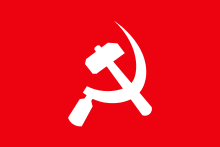Nepal Communist Party
The Nepal Communist Party (NCP) is the ruling political party in Nepal and is the largest communist party in South Asia and the third largest in Asia.[7] It was founded on 17 May 2018, from the unification of two leftist parties, Communist Party of Nepal (Unified Marxist–Leninist) and Communist Party of Nepal (Maoist Centre). The unification was completed by the Party Unification Coordination Committee, after eight months of planning. The two predecessor parties subsequently dissolved, making way for the new united party. The party retains the electoral symbol of the CPN (Unified Marxist-Leninist), the sun.[8][9] The party is the largest political party in the House of Representatives, National Assembly and in all provincial assemblies except No. 2. KP Sharma Oli, Prime Minister of Nepal since 15 February 2018, and former Prime Minister of Nepal Pushpa Kamal Dahal both serve as the chairmen of the party.[10]
Nepal Communist Party नेपाल कम्युनिष्ट पार्टी | |
|---|---|
 | |
| Abbreviation | NCP (नेकपा) |
| Chairperson | KP Sharma Oli and Pushpa Kamal Dahal[1] |
| General Secretary | Bishnu Prasad Paudel |
| Presidium | Secretariat of the Nepal Communist Party |
| Spokesperson | Narayan Kaji Shrestha |
| Parliamentary Party Leader | KP Sharma Oli[2] |
| Founded | 17 May 2018 |
| Merger of | CPN (Maoist Centre) CPN (Unified Marxist–Leninist) |
| Headquarters | Perisdada, Koteshwar, Kathmandu and Aakirti Marg, Dhumbarahi, Kathmandu |
| Student wing | All Nepal National Free Students Union |
| Youth wing | National Youth Federation Nepal |
| Labour wing | GEFONT ANTUF |
| Ideology | Communism People's Multiparty Democracy[3] Marxism–Leninism[3] Democratic centralism[4] Secularism[4] Federalism Factions: Market socialism Marxism–Leninism–Maoism–Prachanda Path |
| Political position | Left-wing[5] Factions: Centre-left to Far-left |
| International affiliation | IMCWP[6] |
| Colors | Red |
| Anthem | "The Internationale" |
| House of Representatives | 174 / 275 |
| National Assembly | 50 / 59 |
| Provincial Assemblies | 350 / 550 |
| Party flag | |
 | |
| Website | |
| ncp | |
| Part of a series on |
| Communist parties |
|---|
|
Africa
|
|
Europe
Former parties |
|
Oceania
Former parties
|
|
Related topics |
|
| Part of a series on |
| Maoism |
|---|
 |
|
People
|
|
Theoretical works |
|
History
|
|
Related topics |
|
History
Background
On 3 October 2017, the two major communist parties, the Communist Party of Nepal (Unified Marxist-Leninist) and the Communist Party of Nepal (Maoist Centre) along with the Naya Shakti Party announced a coalition for the upcoming legislative and provincial election. The three parties also announced plans for unification following the election with the formation of a Unification Coordination Committee.[11][12][13] On 14 October 2017, Naya Shakti Party broke from the alliance citing differences with the two parties.[14] The alliance between the two parties won a majority in the House of Representatives and in six of the seven provincial assemblies.[15][16][17] Following the elections, it was decided that CPN (Unified Marxist-Leninist) would get chief ministers in Province No. 1, Bagmati Pradesh, Gandaki Pradesh and Province No. 5, and CPN (Maoist Centre) would get chief ministers in Karnali Pradesh and Sudurpashchim Pradesh.[18] The party also won a two third majority in the National Assembly.[19][20] Following the formation of the Federal Parliament of Nepal, parliamentary party leader of the Communist Party of Nepal (Unified Marxist-Leninist), Khadga Prasad Oli was sworn in as Prime Minister on 15 February 2018.[21][22] The merger of the two parties was initially announced for 22 April 2018, to coincide with the formation of the original Communist Party of Nepal in 1949,[23] but the unification was put on hold citing insufficient time to sort out remaining issues.[24]
Unification
The CPN (Unified Marxist-Leninist) and CPN (Maoist Centre) dissolved their central committees on 17 May 2018 and the new party was formed on the same day. Khadga Prasad Oli and Pushpa Kamal Dahal would serve as joint chairmen of the party until a general convention was held.[25][26][27] The party changed its name to Nepal Communist Party (NCP) after the Election Commission of Nepal refused to register the new party as another party called Communist Party of Nepal was already registered the commission.[28][29]
Ideology
As part of the merger agreement, the party's ideology will consist of Marxism–Leninism and support for a multi-party system in Nepal, while the party itself will remain secular and governed by democratic centralism.
Organization and structure
Central organization
Secretariat
A nine-member Secretariat (also known as High Command) of the party has been created. It includes:
- Chairperson: Khadga Prasad Oli, Pushpa Kamal Dahal
- General Secretary: Bishnu Prasad Paudel
- Members: Madhav Kumar Nepal, Jhala Nath Khanal, Bamdev Gautam, Narayan Kaji Shrestha, Ishwor Pokhrel, Ram Bahadur Thapa.[30]
Politburo
A 135 member politburo will be formed after the formation of the standing committee and central committee.[31]
Standing Committee
The 45-member Standing Committee of the Central Political Bureau includes 26 members from CPN (UML) and 19 from CPN (Maoist Centre).[32]
Central Committee
The central committee has a total of 441 members, including 241 from Communist Party of Nepal (Unified Marxist–Leninist), and 200 from Communist Party of Nepal (Maoist Centre).[8]
Lower-level organizations
Federal government
| Pratinidhi Sabha | Rastriya Sabha | Government | Prime Minister/Parliamentary Party Leader |
|---|---|---|---|
174 / 275 |
50 / 59 |
NCP | Khadga Prasad Oli |
Presence in various provinces
| Province | Seats | Government | Chief Minister/Provincial Party Leader |
|---|---|---|---|
| Province No. 1 | 66 / 93 |
NCP | Sher Dhan Rai[33] |
| Province No. 2 | 32 / 107 |
Opposition | Satya Narayan Mandal |
| Bagmati Pradesh | 81 / 110 |
NCP | Dormani Poudel[34] |
| Gandaki Pradesh | 39 / 60 |
NCP | Prithvi Subba Gurung[35] |
| Province No. 5 | 61 / 87 |
NCP | Shankar Pokhrel[36] |
| Karnali Pradesh | 32 / 40 |
NCP | Mahendra Bahadur Shahi[37] |
| Sudurpashchim Pradesh | 39 / 53 |
NCP | Trilochan Bhatta[38] |
References
- https://thediplomat.com/2018/02/the-rebirth-of-the-nepal-communist-party/
- "NCP picks Oli as its Parliamentary Party leader". 19 May 2018.
- Bhattarai, Kamal Dev (21 February 2018). "The (Re)Birth of the Nepal Communist Party". The Diplomat. Retrieved 22 May 2018.
- Ghimire, Yubaraj (21 May 2018). "Next Door Nepal: Hope and fear in Kathmandu". The Indian Express. Retrieved 22 May 2018.
- "Xi's Myanmar visit and China's Regional Diplomacy". Observer Research Foundation. 16 January 2020. Retrieved 9 February 2020.
President Xi’s visit to Nepal in October 2019 came when the ruling communist party in Nepal has consolidated power following the merger of two major left-wing parties to form Nepal Communist Party (NCP) in May 2018.
- IMCWP. "Participants List". IMCWP. Retrieved 16 February 2019.CS1 maint: uses authors parameter (link)
- http://www.china.org.cn/opinion/2018-05/22/content_51482191.htm
- "UML and Maoist Centre to form Nepal Communist Party tomorrow". 16 May 2018.
- "Nepal: Left alliance unifies to form single party". www.aninews.in.
- https://ncp.org.np/content/-6.html
- "UML, Maoist Centre, Naya Shakti Party form electoral alliance for polls". The Himalayan Times. 3 October 2017. Retrieved 21 May 2018.
- "UML, Maoist Center, Naya Shakti to unify". My Republica. Retrieved 21 May 2018.
- "CPN-UML, Maoist Centre, Naya Shakti announce electoral alliance, agree to unify". Retrieved 21 May 2018.
- "Naya Shakti back to poll symbol 'eye'". Retrieved 21 May 2018.
- "Nepal Left alliance wins majority in parliament, economy main trust – Modern Diplomacy". moderndiplomacy.eu. 12 December 2017. Retrieved 21 May 2018.
- India, Press Trust of; India, Press Trust of (14 December 2017). "Nepal's Left alliance gets majority". The Hindu. ISSN 0971-751X. Retrieved 21 May 2018.
- 徐林. "Left Alliance set to form majority government in Nepal – China.org.cn". www.china.org.cn. Retrieved 21 May 2018.
- "UML to get 4 chief ministers, Maoist Centre 2". Retrieved 21 May 2018.
- "Left alliance commands two-thirds majority in NA". Retrieved 21 May 2018.
- "Nepal National Assembly election: Left Alliance gets two third majority | DD News". www.ddinews.gov.in. Retrieved 21 May 2018.
- "KP Sharma Oli sworn in as Nepal PM for second time – Times of India". The Times of India. Retrieved 21 May 2018.
- "KP Sharma Oli appointed Nepal's new prime minister". www.aljazeera.com. Retrieved 21 May 2018.
- "Left alliance unification proposed for April 22". My Republica. Retrieved 21 May 2018.
- "Unification of UML, Maoist Center will not happen on April 22 | Setopati – Nepal's Digital Newspaper". setopati.net. Retrieved 21 May 2018.
- "Nepal's 2 major parties merge to form Nepal Communist Party – Xinhua | English.news.cn". www.xinhuanet.com. Retrieved 22 May 2018.
- "UML- Maoist Center unification approved, new party to be registered today itself". My Republica. Retrieved 22 May 2018.
- "Nepal's two biggest leftist forces merge into Nepal Communist Party – OnlineKhabar". english.onlinekhabar.com. Retrieved 22 May 2018.
- "Unified party changes name after EC refuses to register as CPN underlined | Setopati – Nepal's Digital Newspaper". setopati.net. Retrieved 3 June 2018.
- "नामबाट अण्डरलाईन हट्यो (नेकपा) थपियो". gorkhapatraonline.com. Retrieved 3 June 2018.
- "एमाले र माओवादी मिलेर बन्यो नेपाल कम्युनिष्ट पार्टी". Online Khabar. Retrieved 18 May 2018.
- "Nepal Communist Party to form lower committees, sister organisations within next three months – OnlineKhabar". english.onlinekhabar.com. Retrieved 22 May 2018.
- "Nepal Communist Party will have 441-member Central Committee".
- "Sher Dhan Rai appointed Province 1 Chief Minister – The Himalayan Times". The Himalayan Times. 14 February 2018. Retrieved 31 March 2018.
- "UML PP leader Dor Mani Paudel appointed CM of Province 3". The Himalayan Times. 11 February 2018. Retrieved 31 March 2018.
- "Prithvi Subba Gurung appointed as Province 4 CM – The Himalayan Times". The Himalayan Times. 12 February 2018. Retrieved 31 March 2018.
- "Shankar Pokharel appointed Province 5 CM". The Himalayan Times. 14 February 2018. Retrieved 31 March 2018.
- "Shahi appointed Province 6 CM". The Himalayan Times. 16 February 2018. Retrieved 31 March 2018.
- "Trilochan Bhatta becomes Province 7 chief minister". The Himalayan Times. 16 February 2018. Retrieved 31 March 2018.

